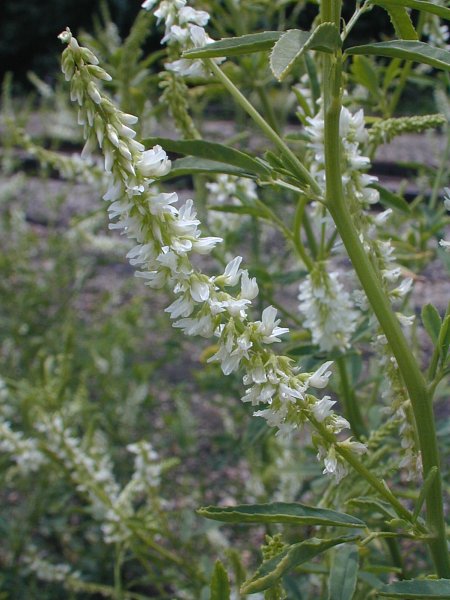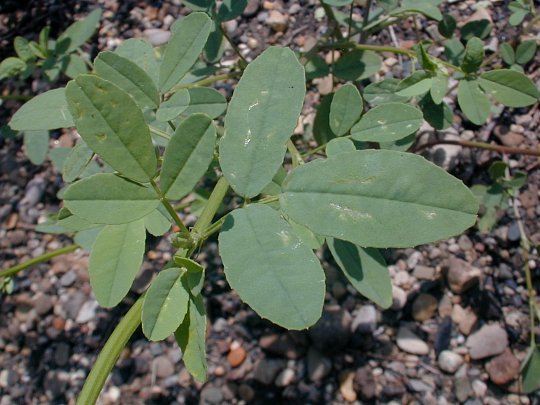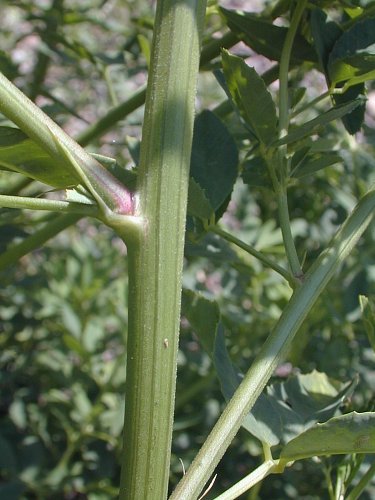Description: This annual or biennial plant is 3-8' tall, branching occasionally and having a lanky appearance. The light green stems are round or slightly terete (i.e., furrowed on all sides) and glabrous. The alternate leaves are trifoliate; they are rather sparsely distributed along the stems and have petioles up to 1" long. The greyish green leaflets are up to 1" long and 1/3" (8 mm.) across. They are hairless, dentate along the upper margins, and oblong or oblong-ovate. There are a pair of small narrow stipules at the base of each trifoliate leaf's petiole. The middle leaflet has a conspicuous petiole of its own (i.e, a petiolule), while the lateral leaflets are nearly sessile.

The upper stems
terminate in narrow racemes of white flowers about 2-6" long. The small
floppy flowers have a tendency to hang downward from the central stalk
of the raceme, and they sometimes appear on only 1 or 2 sides. Each
flower is about 1/3" (8 mm.) long, consisting of 5 white petals and a
light
green calyx with 5 teeth. The flower is tubular at the base, become
becomes broader toward the outer edges of the petals. These petals
consist of a standard, a keel, and a 2 lateral petals; the standard
functions as a protective hood over the keel and is only slightly
ascending. The blooming period occurs from early summer to fall and
lasts about 1-2 months for a colony of plants; this blooming period
reaches a peak during mid-summer. Both the foliage and flowers are
mildly fragrant. Each flower is replaced an ovoid seedpod about 1/3"
long that terminates in a beak and contains 1 or 2 seeds. The surface
of each seedpod is smooth or slightly reticulated. The root system
consists of a taproot that readily divides into abundant secondary
roots. This plant spreads by reseeding itself.
Cultivation:
The preference is full sun, slightly moist to dry conditions, and a
rather heavy clay-loam or gravelly soil. The size of White Sweet Clover
varies considerably with the moisture and fertility of the soil. The
seeds can persist in the ground for several decades and remain viable.
The roots can fix nitrogen into the soil through rhizobial bacteria and
they form a symbiotic association with endomycorrhizal fungi.

Range &
Habitat:
White Sweet Clover is a common plant that occurs in every county of
Illinois (see Distribution
Map). It was introduced into the United States from Eurasia
as a green manure for fields and as forage for livestock. Habitats
include limestone glades, thinly wooded bluffs, prairies, weedy
meadows, old fields, vacant lots, areas along railroads and roadsides,
and waste areas. This species can invade prairies and other natural
habitats, where it is regarded as a nuisance by ecologists. However, it
is even more common in areas with a history of disturbance.
Faunal Associations:
The nectar of the flowers attracts many kinds of insects, including
long-tongued bees, short-tongued bees, wasps, flies, butterflies,
skippers, beetles, and plant bugs. Short-tongued bees also collect
pollen. White Sweet Clover is considered an excellent nectar plant for
Apis mellifera (Honey Bee) by beekeepers. The caterpillars of Blue and
Sulfur butterflies feed on foliage, buds, or flowers, including Hemiargus
isola (Reakirt's Blue), Glaucopsyche lygdamus
couperi (Silvery Blue), Colias philodice
(Clouded Sulfur), and Colias eurytheme (Orange
Sulfur). The caterpillars of the moth Scopula inductata
(Soft-Lined Wave) feed on the foliage, while the caterpillars of Washia
miscecolorella (Sweet Clover Root Borer Moth) bore into the
stems and roots. Foliage is eaten by the White-Tailed Deer, Cottontail
Rabbit, and livestock. However, improperly cured fodder that is derived
from this and other Melilotus spp. (Sweet Clovers)
can be mildly toxic to livestock. Some upland gamebirds occasionally
eat the seeds, including the Greater Prairie Chicken.

Photographic
Location:
A gravelly area along a railroad in Urbana, Illinois.
Comments:
This species is very similar in appearance to Melilotus
officinalis (Yellow Sweet Clover). As a matter of fact, some
authorities regard them as the same species with differently colored
flowers, in which case White Sweet Clover is referred to as Melilotus
officinalis alba. Other authorities, including Mohlenbrock
(2002), consider White Sweet Clover a separate species. This species
has a tendency to bloom about 2-4 weeks later than Yellow Sweet Clover,
and its foliage is more greyish green, rather than plain green. The
seedpods of White Sweet Clover lack transverse wrinkles, which are
occasionally present in the seedpods of Yellow Sweet Clover.